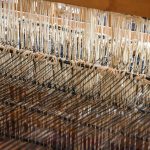Acetate fabric is lightweight and smooth but doesn’t breathe as well as natural fibers like cotton or linen. You’ll find it absorbs some moisture but traps sweat against your skin, which can feel sticky and uncomfortable in hot weather. It dries slower and has limited airflow due to its tight weave. However, it drapes beautifully and works for dressy looks. Keep exploring if you want tips on styling, caring, and better fabric alternatives for warm climates.
Table of Contents
Key Takeaways
- Acetate fabric has limited breathability due to its smooth texture and tight weave, which restrict airflow.
- It absorbs moderate moisture but dries slowly, potentially causing a sticky, uncomfortable feeling in hot weather.
- Lightweight and silky, acetate feels comfortable but may trap sweat against the skin, increasing heat discomfort.
- Wearing loose, flowing acetate garments and pairing them with breathable fabrics improves ventilation and comfort.
- For hot climates, choose lighter acetate colors and avoid excessive layering to reduce heat retention.
What Is Acetate Fabric Made Of?
Acetate fabric comes from cellulose, a natural material found in plants like wood pulp or cotton fibers.
When you wear acetate, you’re actually wearing a semi-synthetic fabric because cellulose undergoes chemical processing before it becomes fiber. This process transforms the natural cellulose into a fiber called cellulose acetate through acetylation, where acetic acid reacts with the cellulose.
Afterward, the cellulose acetate is spun into fibers that can be woven or knitted into fabric. You’ll find acetate often blended with other fibers or used alone for its silk-like appearance and smooth texture.
While it originates from natural sources, the chemical treatment gives acetate unique qualities that differ from pure natural fabrics. Understanding this origin helps you see why acetate behaves differently than cotton or linen.
Key Properties of Acetate Fabric
You’ll want to understand how acetate fabric handles moisture absorption and airflow before deciding if it’s breathable.
These properties directly affect comfort and wearability.
Let’s explore how acetate performs in these areas.
Moisture Absorption Ability
How well does this fabric handle moisture? Acetate fabric has moderate moisture absorption, meaning it can soak up some sweat but not as effectively as natural fibers like cotton.
When you wear acetate in hot weather, it absorbs a fair amount of moisture, helping you feel less sticky initially. However, it doesn’t hold moisture for long and tends to dry quickly. This quick-drying trait can be a plus if you want to avoid that damp, clingy feeling after sweating.
On the flip side, since acetate doesn’t absorb moisture deeply, it mightn’t manage heavy perspiration well, potentially leaving you feeling damp if you sweat a lot.
Airflow and Ventilation
While acetate manages moisture reasonably well, its ability to keep you comfortable also depends on how well air flows through the fabric.
Acetate has a smooth, silky texture but doesn’t have an open weave like cotton or linen, so the airflow is somewhat limited. This means it won’t ventilate as effectively, potentially trapping heat and humidity close to your skin in hot weather.
However, if the acetate fabric is blended with more breathable fibers or designed with a looser weave, it can improve ventilation and help you stay cooler.
When choosing acetate clothing for warm days, look for styles that promote airflow, like loose fits or vents, so the fabric can breathe better and keep you comfortable.
How Breathable Is Acetate Compared to Other Fabrics?
When comparing acetate to other fabrics, you’ll notice it offers moderate breathability but doesn’t match natural fibers like cotton or linen. Acetate’s semi-synthetic nature means it allows some airflow but tends to trap heat more than natural fabrics. Here’s a quick look at how acetate stacks up against common materials:
| Fabric | Breathability | Moisture Wicking |
|---|---|---|
| Acetate | Moderate | Low to Moderate |
| Cotton | High | High |
| Linen | Very High | High |
| Polyester | Low | Low |
Advantages and Disadvantages of Wearing Acetate in Hot Weather
When you wear acetate in hot weather, you’ll appreciate its lightweight and comfortable feel that keeps you from feeling weighed down.
However, you might struggle with moisture management since acetate doesn’t wick sweat as effectively as some other fabrics.
Knowing these pros and cons can help you decide if acetate suits your warm-weather wardrobe.
Moisture Management Challenges
Because acetate fabric doesn’t absorb moisture well, it can leave you feeling sticky and uncomfortable in hot weather. When you sweat, the fabric won’t soak up the moisture, so it tends to sit on your skin, making you feel clammy.
This can be especially challenging if you’re active or in humid conditions. You might notice the fabric clings awkwardly or takes longer to dry, which affects your comfort throughout the day.
Here are a few moisture management challenges you should consider:
- Acetate traps sweat against your skin, increasing discomfort.
- The fabric dries slowly, prolonging dampness.
- Lack of breathability reduces airflow, worsening moisture buildup.
Knowing these issues helps you decide when acetate is suitable for your hot-weather wardrobe.
Lightweight and Comfortable Feel
Despite its moisture management drawbacks, acetate fabric offers a lightweight and smooth texture that many find comfortable in hot weather.
When you wear acetate, you’ll notice how soft it feels against your skin, reducing irritation on hot, sweaty days. Its silky finish gives a luxurious touch, making it ideal for dressy summer occasions.
Plus, acetate drapes well, so your clothes will hang nicely without feeling heavy or bulky. However, keep in mind that acetate doesn’t breathe as well as natural fibers, so you might feel sticky if you sweat a lot.
Still, if you prioritize comfort and elegance in warm weather, acetate can be a good choice—just remember to stay in well-ventilated areas to avoid overheating.
Styling Tips for Acetate Clothing in Warm Climates
Although acetate fabric offers a smooth and silky feel, you’ll want to style it thoughtfully to stay comfortable in warm climates.
Acetate feels silky smooth but requires careful styling to stay comfy in warm weather.
Since acetate isn’t as breathable as natural fibers, pairing it with the right pieces and choosing the right fits can make a big difference in how you feel throughout the day.
Here are some tips to help you wear acetate stylishly without overheating:
- Opt for loose, flowing acetate garments that encourage air circulation and prevent clinging to your skin.
- Combine acetate items with breathable fabrics like cotton or linen to balance comfort and style.
- Choose lighter colors and minimal layering to reflect sunlight and reduce heat buildup.
Caring for Acetate Garments During Summer
When temperatures rise, taking care of your acetate garments becomes essential to keep them looking fresh and comfortable.
You should always hand wash acetate in cold water with a gentle detergent to prevent damage. Avoid wringing or twisting the fabric; instead, gently press out excess water and lay the garment flat to dry away from direct sunlight.
If you need to iron, use a low heat setting and place a cloth between the iron and fabric to avoid scorching.
Storing acetate pieces in a cool, dry place helps prevent wrinkles and keeps the fibers intact. Also, steer clear of harsh chemicals and bleach, which can weaken the fabric.
Alternatives to Acetate for Breathable Summer Clothing
If you want to stay cool and comfortable during hot weather, choosing the right fabric is key. While acetate has its charm, you might find better breathability with alternatives designed for summer heat.
These fabrics help wick moisture away and allow air circulation, keeping you fresh all day. Here are some great options to bear in mind:
- Linen: Known for its exceptional breathability and lightweight feel, linen lets air flow freely and dries quickly.
- Cotton: A classic choice, cotton is soft, breathable, and absorbs sweat effectively.
- Bamboo: This eco-friendly fabric offers excellent moisture-wicking properties and is naturally breathable.
Switching to these fabrics can make a noticeable difference in your comfort when temperatures rise.
Frequently Asked Questions
Does Acetate Fabric Wrinkle Easily in Hot Weather?
Yes, acetate fabric tends to wrinkle easily, especially in hot weather. You’ll notice creases form quickly because it’s less resistant to heat and moisture, so handle it gently and avoid excessive sweating to keep it looking smooth.
Can Acetate Fabric Cause Allergies or Skin Irritation?
You’d think acetate fabric would cause instant skin riots, but it rarely does. Still, if you’ve got sensitive skin, it might irritate or trigger allergies. Always test a small patch before committing to a full outfit.
Is Acetate Fabric Environmentally Friendly or Sustainable?
You shouldn’t expect acetate fabric to be very eco-friendly since it’s made from wood pulp but involves chemical processing. While it’s biodegradable, the production’s environmental impact means it’s less sustainable compared to natural fibers.
How Does Acetate Fabric React to Sweat and Moisture?
When sweat beads on acetate, it feels like a glossy coat trapping moisture close to your skin. You’ll notice it absorbs sweat but dries slowly, so staying fresh in hot weather can be a bit challenging with this fabric.
Can Acetate Be Blended With Other Fabrics for Better Breathability?
You can definitely blend acetate with fabrics like cotton or linen to boost breathability. These blends help wick moisture better and keep you cooler, making acetate more comfortable for hot weather wear.
- Does Chiffon Fabric Stink - July 15, 2025
- Does Chiffon Fabric Affect the Economy - July 15, 2025
- Does Cotton Fabric Have a Nap - July 15, 2025







